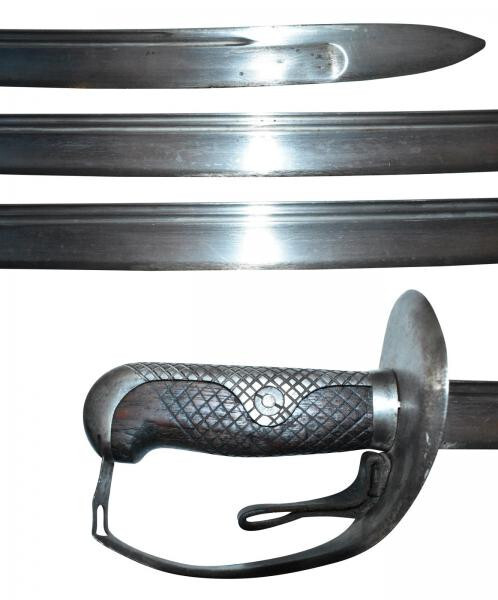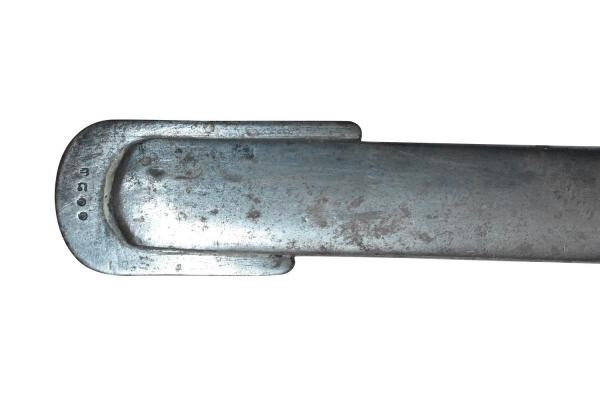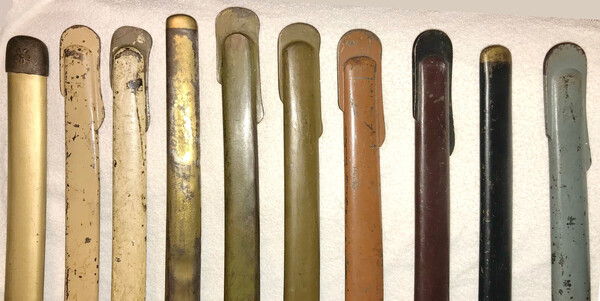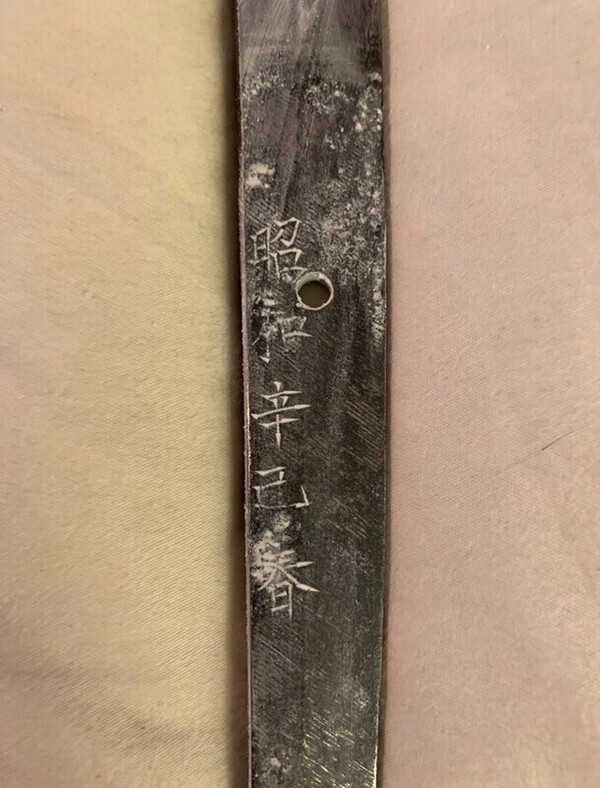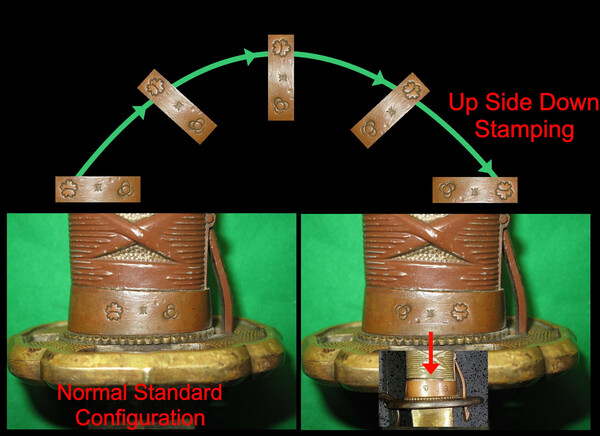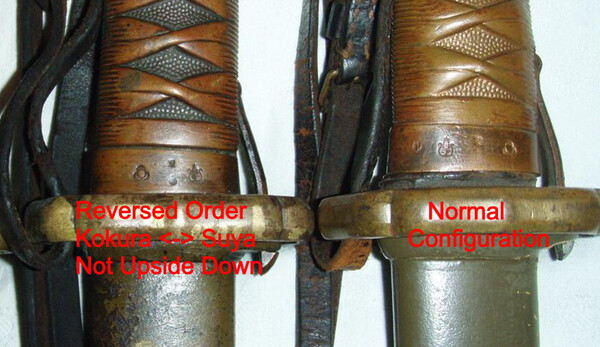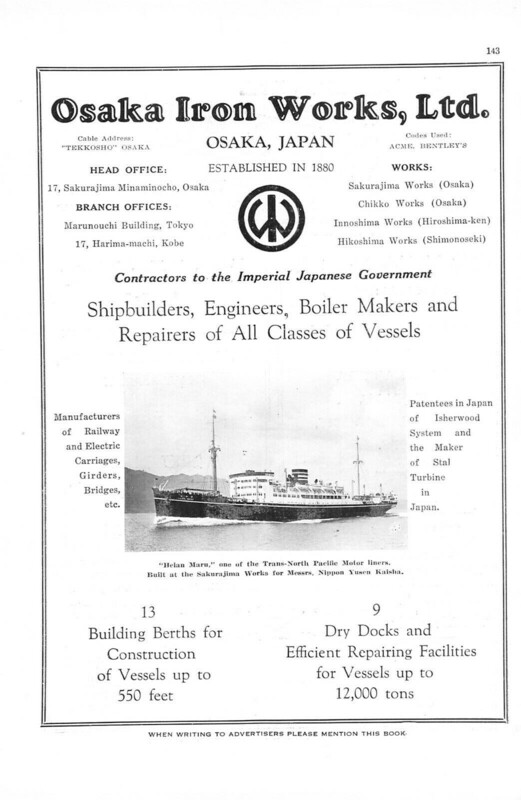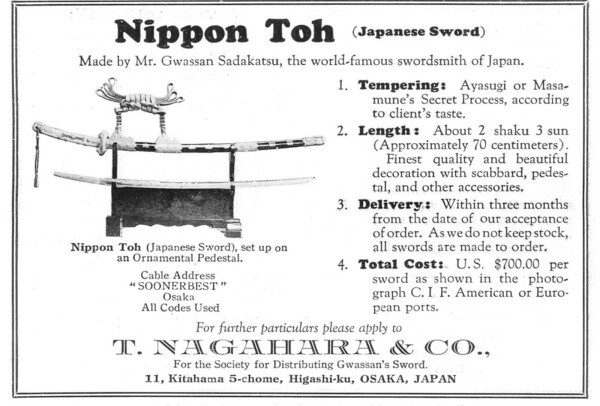-
Posts
418 -
Joined
-
Last visited
-
Days Won
9
Content Type
Profiles
Forums
Events
Store
Downloads
Gallery
Everything posted by Stegel
-

Type 95 Naval / Navy saya re paint
Stegel replied to robinalexander's topic in Military Swords of Japan
Hi Rob, I'm with you in that i thought for sure the sword i have was a post war 'bubba' job, now yours is the second one i have seen in all my collecting time. In Bruce's other thread i had mine also included in the photo, but merely wanted to show a range of scabbard colours i have seen and own. Having owned quite a few black scabbard nco's, i didn't see the big problem with them and had my doubts with all the negativity surrounding them. All references in English give just the basic Olive drab from factory description, nothing else, and yet clearly others do exist, even Nickel plated ones, but they are not mentioned either. When the IJA Camouflage Manual was discussed over at the WRF, it describes the 4 BASIC Colours used for camouflage purposes only. I looked into them from the Modellers veiwpoint ( they are meticulous on detail and historical accuracy) and made up the colour chart which i posted in Bruces thread. We all know that other colours were used, such as yellow, orange, red, the whites and blacks. The 'Red Bean' also gets a mention by Nick over at WRF, but all these are not the 4-Basic Camouflage colours, so make of that what you will. Anyway, to make a long story short, i began to look into the other colours and found a huge variety.... Early war, Late War, even the AIr Wing which was part of the IJA but the IJN had its own. There are LOTS of colours. When i made the comment i was referring to the colour itself, and i still stand by this comment. There were 4 different Naval arsenals that performed ship building and re-fitting of ships. Each of these had their own distinct colour version of greys, blues etc. There is a huge variation in the greys and what is a standard colour compared to a 'camouflage' colour is out of my scope for now as we would need IJN manuals to be able to go further. Here is a chart of the 4 colours used by the shipbuilding arsenals, although not shown, the first one has 4 variants, the second one 3, and the third one 2. Also a photo mix of my 'Grey' type 95. Before i forget, it's good that Thomas asked for your serial numbers, although your blade is Kobe (Ichi), the scabbard is from Iijima (by serial numbers) which is still a Tokyo Arsenal sub contractor. Mine is also an Iijima produced sword (matching numbers) and also Grey painted over the Olive Drab original paint. Just for interest i thought i'd share another recent find with you here. This time a Suya produced sword(again Tokyo Arsenal), but it has a Nickel plated Tsuba and 'Blue' scabbard. It appears to have been stripped prior to the blue being applied, however there are traces of brown under the scabbard throat. My understanding is that the IJN, didn't issue NCO's with swords, however, their Land Garrisons and NLF may have been different...they were essentially infantry under Naval Command. I have a Type 98 with black painted wooden scabbard and black suede combat cover in my collection, it came with a Sam Brown style belt aswell, all from a vet who acquired it in New Guinea from a NLF member. I remember reading that a lot of these were re-posted with IJA units towards the end of the war, but don't quote me just yet, as i need to find more references and could be wrong. Perhaps there could be a link here to explain some of these strange scabbard colours we have. Otherwise, it's all just Post War 'Bubba' activity at it's best. -
Thanks for sharing Thomas, It seems Japan and Thailand sourced items from Germany in the early days. I have what i believe is a Japanese made "Type 32" style sword, made specifically for the Thai military. Thought i'd share it here as it seems appropriate. Hope you all enjoy.
-
Great find Bill !! Personally i believe the story, as i remember my Mother telling me how BAD it was straight after the war, shortages were peaking in almost everything till after the clean up and economy rising again. The 10lbs of sugar would have been worth a small fortune at the time, it would get you other things in a barter deal and keep your family from starvation.... worth more than a sword which won't feed your famiy and would end up being confiscated eventually, leaving you with nothing! Just my opinion. I'm with Steve and Marco, please show us more of the blade and smith details. I have a Generals sword also, but it was surrendered in Malaya, and the British were a bit more exact in highlighting these things especially from surrender ceremonies. here's the plaque on mine. The blade is an old Shinto mumei, but i have the note the general left with it. Steve, i love reading your comments, great work!! sometimes they really make my day!
-
If we consider the 1943 IJA camouflage document for static and mobile weapons (which also includes Small Arms) as posted and explained by Nick Komiya on the Warrelics forum, i think you can see that of the 4 basic colours mentioned, the 'Hay' (Dead Grass 枯草色 Karekusa-Iro), is the closest to resembling the 'gold' that we are talking about here. Perhaps it was the only available paint, close enough to the dried grass/hay, and was therefore used instead. This colour was used in the grassy plains environment especially during the summer months. The top 4 colours were used prior to 1943, the black (not shown) was now no longer able to be used as an outline colour as it had been in Manchuria proir to the 1943 manual update. White (also not shown) got mentioned for the winter/snow environment, particularly with relation to reflective factors. Here you can see several different colours used on the type 95 scabbards, and sometimes even on the handles. Note the black outline used on the 3rd last sword. The RS scabbard was included as an example of colour used only. The 'Grey' at the end was only used in Naval colour schemes. Bruce, the winter camo swords you posted in post#3, are all mine except for the second one down.
-

Attention Mantetsu Owners: A Survey
Stegel replied to Bruce Pennington's topic in Military Swords of Japan
Bruce, another for your list... link here: https://www.militaria.co.za/nmb/topic/38007-a-little-help-please/ -
Yes, thats it thanks for that
-
There should be some little markings on the back of the tang (the top, near the collar and guard when held in hand). Take a picture of that also, it will give the series production number. Bruce Pennington has a database for these and a topic to read is called Attention Mantetsu owners .
-

Legendary zig-zag stitch Kai Gunto tassel
Stegel replied to PNSSHOGUN's topic in Military Swords of Japan
Great observation John! -
I may be showing my ignorance here, but this looks like an older blade to me, shinto / shin shinto period?
-
Nice pick up Paul ! i noticed that the sarute barrel nut (which holds the handle to the blade) is actually a replacement. Whether it was an Arsenal re-work, or field repair, or even post war replacement by someone wanting to see if there was a signature is almost impossible to tell. The original barrel nuts were also made of copper. Would you be able to post a photo of the drag please? (an overhead shot, not on the angle as your other photos) It looks as if the brass plug is semi circular in appearance. Stephen, Dawsons book only lists #6561 as the highest 'observed' serial number, no photographic evidence unfortunately. The source is unknown, however, he mentions {various sources but primarily Donald Barnes}, who also assisted Fuller & Gregory with their list. His list also mentions the cross blade stamping of 501 (which is generally between the end of the bohi and the habiki) for this sword so i would be inclined to believe it is a real observation. The earliest Aluminium handled sword i have observed is #6756, so to answer your question directly..... Bruce is on the mark, as the cut off is somewhere inbetween!
-
Thanks Matt, extra pics added for future reference and interest in this thread. These are better, so the colour of the scabbard, and patina of the handle is much more evident. Very nice and Minty sword, (not Mint......but damn close! -for John's benefit)
-

Emergency Late War Officer Gunto
Stegel replied to Bruce Pennington's topic in Military Swords of Japan
You can find the link here Now it is only a drawing, and no real details are available except that the slot for the tassel mount is omitted. None have ever been seen on type 95's, in fact the replacement was the round 'steel' tsuba from Pattern 3 onwards. The actual link between this announcement and the tsubas on this thread is fairly weak, but these here are thinner, have the same shape and no slots for mounting tassels. I just thought it was worth noting and keeping in mind when looking at some of these, and wanted to share the idea around. -
Yes, i remember now, -having just checked again. You are correct in what you say, the 東 inspection mark only begins to show from about 1200 onwards. However, there is one sword at the 780 mark that does appear to have traces of the inspection stamp after the serial number, very faint, almost as if it was buffed off or poorly struck. It is no where near as clean as this one here. Thanks for highlighting this little factoid! Very interesting!
-
Thanks for confirming the S/N Matt, Kiipu, I’ll have to get back to you on that, not near my computer at the moment
-
The 2nd photo that Vajo posted shows the serial number, I believe it is 871 and not 371. A clearer photo would help as the lighting appears to be from the side. Mdiddy, could you confirm the serial number please?
-

Emergency Late War Officer Gunto
Stegel replied to Bruce Pennington's topic in Military Swords of Japan
Any one notice that they all have the same shaped/style tsuba? both brass and steel as materials are present. Nick K posted a document with a similar looking tsuba in the type 95 thread. It was the announcement for the removal of the tassel mounting hole and also the introduction of the leather tassel 'without' the buckle, as used on all 'non- brass' tsuba type 95's. Essentially this was a contingency 'Rinji' announcement. -
Given the serial number of the blade, the scabbard drag is correct. Looking at the colour of the scabbard, i would tend to agree with Bruce's mixed feelings. It appears a bit 'lime' green to me, but it could be just the photo settings after editing for publication. (adjustments to light levels, etc) There are a few scuffs present so it is not 'Mint' as per John's definitions (thanks for them John), but, i think it's a little better than 'Near Mint' if that's possible. Appears to be a very nice example.
-
That anchor is for the Kure Naval Arsenal
-
Welcome Thomas Thanks for the nice intro and background story. Did your Dad actually have a type 95 or was it the type 98? The one you have shown would have been made by the sub contractor Kobe for the Tokyo Arsenal and would have used the earlier logo of a 'K' in a cherry blossom. The Steel collar did not lend itself well to Stampings like the Copper ones , so it is rare to see any on these. Here's a pic of what yours could have looked like if it didn't use the steel fitting.
-
The stamps are correct and also in the correct order. Rob nearly got it right, but as BangBang has shown, the fuchi cannot be reassembled upside down. If you look carefully, the whole 'SET' of stamps is upside down. Bruce is right, it looks like human error to me too. A picture is worth a thousand words so i got a chance to play with some software and made this up.
-
Thanks Rob, That makes me feel a bit better! Got to save some pennies and i should be able to cover that, wish it was still offered today!
-
Here's one from the Osaka Iron Works, a ship building company. ( O. I .W) Couldn't help but notice how similar to the SMR logo it is. Hope no smiths made swords here during their lunch breaks and that we may have miss identified it as a manchurian piece!
-
Recently come across this online and thought you guys here might like it. It's an advertisement from an old 1934 travel magazine, obviously aimed at the well off tourists of the time. I don't know the exact value in today's terms but i think it would be quite a few years wages for me! Lots of ads for Japanese companies, some with logo's that might interest a few. Hope you guys enjoy it.
- 14 replies
-
- 10
-

-

Type 95 NCO sword - sold for how much???
Stegel replied to Kolekt-To's topic in Military Swords of Japan
Some interesting comments, so i thought i'd add to the mix. I believe the current market value for these is $750 to $1300, obviously the minty ones are at the higher end. This is from actual Auctions if you consider fleabay only. The ones in this range seem to be moving, there are sellers who shoot over the mark but have the 'make an offer' option, these take a little longer, sometimes even months, but eventually sell to an agreed offer. Lastly there are the dreamers, they shoot at the stars when aiming for the moon. It is like they have been hit with a high greed factor and will not budge, others tend to join in also asking some ridiculous prices. Just like Real Estate agents, these sellers are the ones who are 'artificially' driving the prices up. These tend to remain unsold for many months if not nearly years Don't get me wrong, pristine/unique examples will always command a higher price due to demand, so you get some selling at higher than normal prices. Currently, there are some average swords being offered at (what i consider to be), very high 'fixed' prices. On the same note, some very nice pieces are going to auction at low starts and reasonable finish prices. If i was looking to buy, these are the ones i would be looking at. Don't forget that there are other sources to get these from, Fleabay is not your only option. -
+ 1 zohei to IMO







